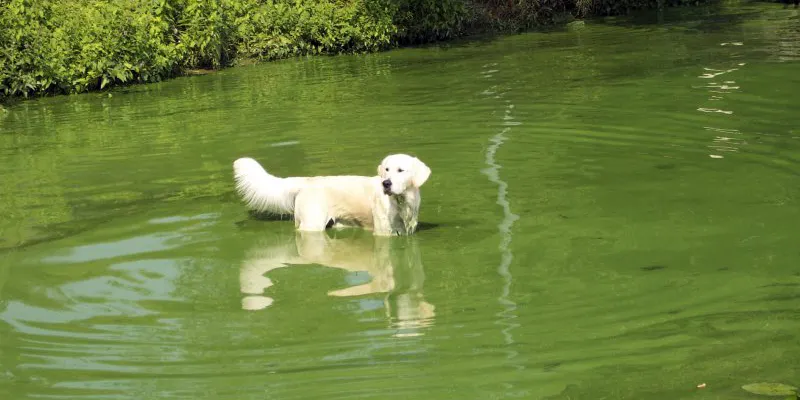Watch out for blue-green algae!
Don't let dogs bathe in colored water - they drink it!
There can be many reasons for vomiting and diarrhea in animals. One of the reasons that is not so well known is blue-green algae which live in lakes, brackish water and seawater that the dog ingests by bathing or drinking the water. Right now there is much more blue-green algae than normal due to the heat wave in Eastern Norway this summer.
Table of contents
What are blue-green algae?
Blue-green algae, despite the name, are not actually algae, but bacteria that produce cyanotoxins, a poison that can cause symptoms in both animals and humans. These blue-green algae are found naturally in soil, air and water, but they also have the ability to bloom in rivers, lakes and oceans. It is important to be aware of the blue-green algae and their potential health effects when traveling near water areas where they may occur.
What are the symptoms?
The symptoms depend on how much and what kind of algal toxins/algal bacteria the dog has ingested. Small dogs often have more pronounced symptoms than large dogs.
General restlessness and tremors are the symptoms that most often first appear when a dog has ingested water with algae toxins. Some toxins can be very irritating to the skin and mucous membranes.
Symptoms such as vomiting or diarrhoea, sometimes with a little blood, can occur quickly after algae poisoning.
Other symptoms can be pale mucous membranes, weakness, breathing difficulties and poor coordination, which can eventually turn into convulsions. Dogs exposed to a large amount of toxic algae can show symptoms as early as 15-60 minutes after ingestion or bathing.

Can cats also be poisoned?
Cats are usually not poisoned because they rarely bathe and thus avoid drinking algae water.
What can you do yourself?
The most important thing is that you get to the vet for treatment as soon as possible.
What does the vet do?
At the vet, rapid treatment is necessary and involves, among other things, removing the algae from the skin by rinsing or bathing. If the dog has drunk water with toxic algae, vomiting may be induced at the vet.
Other treatment is intravenous fluid therapy to maintain circulation and blood pressure and to prevent possible shock development. If the dog gets convulsions, anticonvulsant medication is given directly into the blood. A blood sample is analyzed to get a status of the internal organs, primarily the liver and kidney.
Finishing
The liver's function can be impaired after algae poisoning. Usually, a check-up after a week is recommended to check the liver with a new blood test. Until the check-up, the dog should avoid exercise and training.
If the dog has survived the acute crisis following algae poisoning, the prognosis for a full recovery is good.
Are you wondering if you can bathe yourself? Avoid it if you see such colored bands, flakes, lumps or foam. To be completely safe in a lake, according to the Norwegian Institute of Public Health, you must be able to see the bottom at a depth of 1 metre.
Elisabeth is a veterinarian and authorized ophthalmologist with specialization in eye surgery, as well as further training in internal medicine, general surgery, oral surgery and ultrasound from the European School for Advanced Veterinary Studies in Toulouse.
-
Elisabeth Bjørnestadhttps://www.a-vet.no/author/elisabeth_bjornestad/
-
Elisabeth Bjørnestadhttps://www.a-vet.no/author/elisabeth_bjornestad/
-
Elisabeth Bjørnestadhttps://www.a-vet.no/author/elisabeth_bjornestad/
-
Elisabeth Bjørnestadhttps://www.a-vet.no/author/elisabeth_bjornestad/


